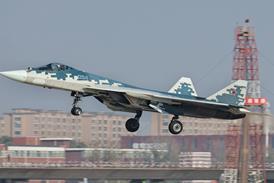US carriers have been swarming south to Mexico in the past couple of years. This challenge, added to competitive pressures at home from low-cost players, is increasingly causing Mexican carriers to look north, reports Mark Pilling
The recent announcement from Mexican low-cost start-up VivaAeroBus that it will launch six new routes from Austin, the state capital of Texas, to various cities south of the border, is a perfect example of the immense interest in serving this cross-border market.
According to analysis from US consultancy The Velocity Group, US and Mexican carriers will have launched no fewer than 59 new nonstop routes in this market in the two years to October. The fact that only 16 of these services are from Mexicans shows how US carriers, particularly Delta (17 routes) and Frontier Airlines (8), have been in the ascendancy.
However, Mexico's flag carriers, Aeromexico and Mexicana, along with local players like Aviacsa, VivaAeroBus and others, are now piling in too. "It has become the new fad, it's what everyone wants to do," says Erika Moore, senior vice-president international sales at Aeromexico.
It is a market that has effectively been an extension of the domestic operations of Mexico's big two. "It's where I need to be and it's what I want my international market to look like," says Moore. "US service will represent 23% of our total operations in capacity terms this year."
Aeromexico's push northwards will at least help it keep up with American, Continental and Delta in market share terms (see table) . All four track at around the same level today but lag Mexicana's 22% share. Privately-owned Mexicana is fighting hard to keep this gap and the unofficial title it gives itself as "California's national airline", so dense is its West Coast network to Mexico. "We will do whatever it takes to maintain our leadership," says Adolfo Crespo, senior vice-president customer service.
. All four track at around the same level today but lag Mexicana's 22% share. Privately-owned Mexicana is fighting hard to keep this gap and the unofficial title it gives itself as "California's national airline", so dense is its West Coast network to Mexico. "We will do whatever it takes to maintain our leadership," says Adolfo Crespo, senior vice-president customer service.
Crespo believes that strong efforts to lower the airline's cost base will enable it to compete effectively against US majors and low-cost players, as well as the plethora of budget carriers arriving in its home market. "Now that we have finished renegotiating with our unions we can get our costs down," he says.
Mexicana's return
Mexicana will focus on international expansion, including a return to some leisure destinations in the USA, while low-cost unit Click Mexicana will concentrate on domestic expansion. However, Click's Fokker 100s could be targeted at some thinner cross-border routes too, says Crespo.
Mexicana is reinforcing its Los Angeles hub by adding frequencies to Mexican cities, says Crespo. It currently has 22 daily arrivals at the airport. Much of the challenge at Los Angeles is coming from Delta, which has added 10 new routes to Mexico from the airport in the past two years.
Tough competition from low-cost carriers at home is one of the main reasons Delta has been adding international service so quickly. The same is true for Aeromexico. "One of the main drivers of our strategy is the rise of the low-cost carriers in the domestic market - it is driving us to look internationally," says Moore. At the beginning of this year international sales at the carrier exceeded domestic sales for the first time, rising fast to 65% of revenue in the first quarter, she says.
Aeromexico has been able to grow fast internationally by using narrowbodies liberated from domestic operations, says Moore. Aircraft on domestic routes have been replaced by regional jets from Aeromexico Connect (formerly Aerolitoral). Its strategy in the USA is to consolidate its presence in gateways like Los Angeles, Chicago, New York, Miami and the main Texan airports.
US low-fare player Frontier Airlines has made a remarkable entrance into the Mexican market over the past five years. Around a fifth of its capacity will be on US-Mexico routes by year-end, growing to 30% by the end of 2008, says Joe Cambron, the carrier's director of planning. "We now have 13 gateways to Mexico, more than any other US carrier," he says, with four in California alone. When including all carriers there are now 46 US gateways to Mexico and 37 Mexican gateways to the USA.
Frontier generally looks to serve tourist destinations. "There is a fuel component to our strategy," Cambron adds, with Frontier aiming to serve destinations that are closer to US cities. Most of its routes are focused on Denver in the USA and Cabo San Lucas, Puerto Vallarta and Cancun in Mexico.
Demand in Cancun is "almost insatiable", says Cambron. The resort city, which is very popular for American holidaymakers, has recovered strongly from hurricanes in 2005.
One of the challenges for Frontier, and for Mexican low-cost players looking to come north, is that over 90% of the traffic originates in the USA. "Anything we get as a point of sale in Mexico is cream," says Cambron, although the carrier is working on strategies to increase its local sales penetration.
Other barriers are the difficulty that Mexican citizens find in obtaining visas to visit the USA, while the high passenger taxes on flights between the US and Mexico, which can add up to over $100, means that "Mexico really can't be that cheap", says Cambron.
Monterrey-based VivaAeroBus, which began operations in late 2006, hopes that it will be able to generate traffic at both ends of its new routes between Mexico and Austin, says Mike Szucs, chief executive. Today all of its operations are in Mexico and it plans to open at least one more base in the country next year, but it also sees a huge opportunity for more cross-border traffic.
It ran a contest earlier this year to see which Texan airport it would serve. "We wanted to see where we could get the greatest support," says Szucs. It plans to begin the first of six routes from Austin to Mexican cities by year-end depending on whether it can lease aircraft at the right rates to add to its five Boeing 737-300s.
A major factor in Austin's favour is its willingness, in partnership with GECAS, to build a new low-cost terminal at the airport. VivaAeroBus will move into this terminal next year when it is finished, says Szucs.
A Texan player that has its eyes on Mexico is Southwest. "That's in the 2010 plus pipeline," says executive vice-president Bob Jordan. "We've got a strategy to get us there but it's a multi-year strategy."
Mexican carrier Aviacsa too is boosting its cross-border flights with new routes from Miami to Cancun and Monterrey. But it is cautious. "The competition is too strong from the US airline side - there are many regional flights from Los Angeles and they are very aggressive," says Manuel Chung, director of planning.
There are good reasons to be careful, says Moore of Aeromexico, who believes the US carriers have been over-expanding. The rise in capacity has hit the yields of all players. "Everyone is suffering," she says. "There has been a 13% drop in our average fares sold on US routes over the last year, with West Coast fares dropping over 20%," she says. This has come alongside new immigration rules for US-Mexico travel which have depressed demand.
Despite these difficulties, network planners appear undeterred and are keeping new US-Mexico service at the top of their agendas.
More details
Network Latin America is a new Airline Business route planning event.
Dates 2-4 December
Venue Monterrey, Mexico
Event organisers Airline Business
Conference manager Emma Lidefjard
Tel +44 20 8652 8846
e-mail Emma Lidefjard
Network Latin America online
Source: Airline Business























